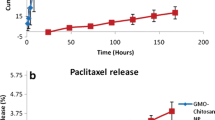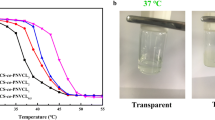Abstract
Purpose
Chitosan, a natural and biocompatible cationic polymer, is an attractive carrier for small interfering RNA (siRNA) delivery. The purpose of this study was to develop a chitosan-based hybrid nanocomplex that exhibits enhanced physical stability in the bloodstream compared with conventional chitosan complexes. Hybrid nanocomplexes composed of chitosan, protamine, lecithin, and thiamine pyrophosphate were prepared for systemic delivery of survivin (SVN) siRNA.
Methods
Physicochemical properties of the nanoparticles including mean diameters and zeta potentials were characterized, and target gene silencing and cellular uptake efficiencies of the siRNA nanocomplexes in prostate cancer cells (PC-3 cells) were measured. In vivo tumor targetability and anti-tumor efficacy by systemic administration were assessed in a PC-3 tumor xenograft mouse model by near-infrared fluorescence (NIRF) imaging and tumor growth monitoring, respectively.
Results
Mean diameters of the SVN siRNA-loaded hybrid nanocomplex (GP-L-CT) were less than 200 nm with a positive zeta potential value in water and were maintained without aggregation in culture media and 50% fetal bovine serum. SVN expression in PC-3 cells was reduced to 21.9% after treating with GP-L-CT. The tumor targetability and growth inhibitory efficacies of GP-L-CT supported the use of this novel hybrid nanocomplex as a cancer therapeutic and as a theranostic system for systemic administration.
Conclusions
A chitosan-based hybrid nanocomplex was successfully developed for the systemic delivery of SVN siRNA, which could serve as an alternative to cationic polymeric nanoparticles that are unstable in serum.








Similar content being viewed by others
Abbreviations
- Cryo-TEM:
-
Cryo-transmission electron microscopy
- EPR:
-
Enhanced permeability and retention
- NIRF:
-
Near-infrared fluorescence
- RNAi:
-
RNA interference
- SCID:
-
Severe combined immunodeficiency
- siRNA:
-
Small interfering ribonucleic acid
- TPP:
-
Thiamine pyrophosphate
References
Davaa E, Ahn IH, Kang BS, Lee SE, Myung CS, Park JS. Preliminary study to determine the optimal conditions for the simultaneous complexation of siRNA and plasmid DNA. J Pharm Invest. 2013;43:499–505.
Wang J, Lu Z, Wientjes MG, Au JL-S. Delivery of siRNA therapeutics: barriers and carriers. AAPS J. 2010;12:492–503.
Behlke MA. Progress towards in vivo use of siRNAs. Mol Ther. 2006;13:644–70.
Whitehead KA, Langer R, Anderson DG. Knocking down barriers: advances in siRNA delivery. Nat Rev Drug Discov. 2009;8:129–38.
Zhang S, Zhao Y, Zhi D, Zhang S. Non-viral vectors for the mediation of RNAi. Bioorg Chem. 2012;40:10–8.
Khalil IA, Kogure K, Akita H, Harashima H. Uptake pathways and subsequent intracellular trafficking in nonviral gene delivery. Pharmacol Rev. 2006;58:32–45.
Ping Y, Liu C, Zhang Z, Liu KL, Chen J, Li J. Chitosan-graft-(PEI-β-cyclodextrin) copolymers and their supramolecular PEGylation for DNA and siRNA delivery. Biomaterials. 2011;32:8328–41.
Singha K, Namgung R, Kim WJ. Polymers in small-interfering RNA delivery. Nucleic Acid Ther. 2011;21:133–47.
Mao S, Sun W, Kissel T. Chitosan-based formulations for delivery of DNA and siRNA. Adv Drug Deliv Rev. 2010;62:12–27.
Malmo J, Hanne S, Vårum KM, Strand SP. SiRNA delivery with chitosan nanoparticles: molecular properties favoring efficient gene silencing. J Control Release. 2012;158:261–8.
Techaarpornkul S, Wongkupasert S, Opanasopit P, Apirakaramwong A, Nunthanid J, Ruktanonchai U. Chitosan-mediated siRNA delivery in vitro: effect of polymer molecular weight, concentration and salt forms. AAPS PharmSciTech. 2010;11:64–72.
Park S, Jeong EJ, Lee J, Rhim T, Lee SK, Lee KY. Preparation and characterization of nonaarginine-modified chitosan nanoparticles for siRNA delivery. Carbohydr Polym. 2013;92:57–62.
Fernandes JC, Qiu X, Winnik FM, Benderdour M, Zhang X, Dai K, et al. Low molecular weight chitosan conjugated with folate for siRNA delivery in vitro: optimization studies. Int J Nanomedicine. 2012;7:5833–45.
Malhotra M, Tomaro-Duchesneau C, Prakash S. Synthesis of TAT peptide-tagged PEGylated chitosan nanoparticles for siRNA delivery targeting neurodegenerative diseases. Biomaterials. 2013;34:1270–80.
Han HD, Mangala LS, Lee JW, Shahzad MM, Kim HS, Shen D, et al. Targeted gene silencing using RGD-labeled chitosan nanoparticles. Clin Cancer Res. 2010;16:3910–22.
Malhotra M, Lane C, Tomaro-Duchesneau C, Saha S, Prakash S. A novel method for synthesizing PEGylated chitosan nanoparticles: strategy, preparation, and in vitro analysis. Int J Nanomedicine. 2011;6:485–94.
Karmali PP, Simberg D. Interactions of nanoparticles with plasma proteins: implication on clearance and toxicity of drug delivery systems. Expert Opin Drug Deliv. 2011;8:343–57.
Radomski A, Jurasz P, Alonso-Escolano D, Drews M, Morandi M, Malinski T, et al. Nanoparticle-induced platelet aggregation and vascular thrombosis. Br J Pharmacol. 2005;146:882–93.
Dobrovolskaia MA, Aggarwal P, Hall JB, McNeil SE. Preclinical studies to understand nanoparticle interaction with the immune system and its potential effects on nanoparticle biodistribution. Mol Pharm. 2008;5:487–95.
Matsuura M, Yamazake Y, Sugiyama M, Kondo M, Ori H, Nango M, et al. Polycation liposome-mediated gene transfer in vivo. Biochim Biophys Acta. 2003;1612:136–43.
Ragelle H, Vandermeulen G, Préat V. Chitosan-based siRNA delivery systems. J Control Release. 2013;172:207–18.
Xu S, Dong M, Liu X, Howard KA, Kjems J, Besenbacher F. Direct force measurements between siRNA and chitosan molecules using force spectroscopy. Biophys J. 2007;93:952–9.
Doolittle H, Morel A, Talbot D. Survivin-directed anticancer therapies – A review of pre-clinical data and early-phase clinical trials. Eur Oncol. 2010;6:10–4.
Kundu AK, Chandra PK, Hazari S, Pramar YV, Dash S, Mandal TK. Development and optimization of nanosomal formulations for siRNA delivery to the liver. Eur J Pharm Biopharm. 2012;80:257–67.
Delgado D, Pozo- Rodríguez A, Solinís MA, Rodríguez-Gascón A. Understanding the mechanism of protamine in solid lipid nanoparticle-based lipofection: The importance of the entry pathway. Eur J Pharm Biopharm. 2011;79:495–502.
DeLong RK, Akhtar U, Sallee M, Parker B, Barber S, Zhang J, et al. Characterization and performance of nucleic acid nanoparticles combined with protamine and gold. Biomaterials. 2009;30:6451–9.
Li S, Huang L. In vivo gene transfer via intravenous administration of cationic lipid–protamine–DNA (LPD) complexes. Gene Ther. 1997;4:891–900.
Yuan H, Zhang W, Du Y, Hu F. Ternary nanoparticles of anionic lipid nanoparticles/protamine/DNA for gene delivery. Int J Pharm. 2010;392:224–31.
Rojanarata T, Opanasopit P, Techaarpornkul S, Ngawhirunpat T, Ruktanonchai U. Chitosan-thiamine pyrophosphate as a novel carrier for siRNA delivery. Pharm Res. 2008;25:2807–14.
Crawford R, Dogdas B, Keough E, Haas RM, Wepukhulu W, Krotzer S, et al. Analysis of lipid nanoparticles by Cryo-EM for characterizing siRNA delivery vehicles. Int J Pharm. 2011;403:237–44.
Mayen V, Wutikhun T, Ketchart O, Kopermsub P. Adsorption of siRNA into mesoporous silica nanoparticles. J Microsc Soc Thai. 2012;5:10–3.
Cho HJ, Yoon HY, Koo H, Ko SH, Shim JS, Lee JH, et al. Self-assembled nanoparticles based on hyaluronic acid-ceramide (HA-CE) and Pluronic® for tumor-targeted delivery of docetaxel. Biomaterials. 2011;31:7181–90.
Kalsin AM, Kowalczyk B, Smoukov SK, Klajn R, Grzybowski BA. Ionic-like behavior of oppositely charged nanoparticles. J Am Chem Soc. 2006;128:15046–7.
Suh MS, Shim G, Lee YH, Han SE, Yu YH, Choi Y, et al. Anionic amino acid-derived cationic lipid for siRNA delivery. J Control Release. 2009;140:268–76.
Sternberg B, Hong K, Zheng W, Papahadjopoulos D. Ultrastructural characterization of cationic liposome-DNA complexes showing enhanced stability in serum and high transfection activity in vivo. Biochim Biophys Acta. 1998;1375:23–35.
Han SE, Kang H, Shim GY, Suh MS, Kim SJ, Kim JS, et al. Novel cationic cholesterol derivative-based liposomes for serum-enhanced delivery of siRNA. Int J Pharm. 2008;353:260–9.
Juliano R, Bauman J, Kang H, Ming X. Biological barriers to therapy with antisense and siRNA oligonucleotides. Mol Pharm. 2009;6:685–95.
ACKNOWLEDGMENTS AND DISCLOSURES
This work was supported by the Ministry of Knowledge Economy of Korea (10030044, SM. Noh).
Author information
Authors and Affiliations
Corresponding author
Electronic supplementary material
Below is the link to the electronic supplementary material.
ESM 1
(DOC 1066 kb)
Rights and permissions
About this article
Cite this article
Ki, MH., Kim, JE., Lee, YN. et al. Chitosan-Based Hybrid Nanocomplex for siRNA Delivery and Its Application for Cancer Therapy. Pharm Res 31, 3323–3334 (2014). https://doi.org/10.1007/s11095-014-1422-3
Received:
Accepted:
Published:
Issue Date:
DOI: https://doi.org/10.1007/s11095-014-1422-3




